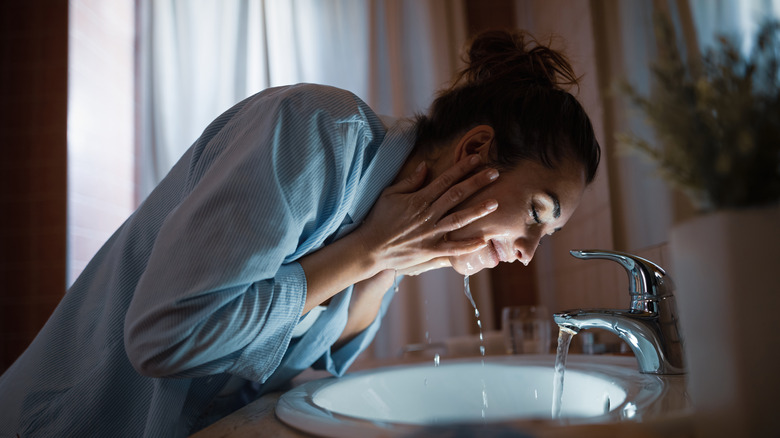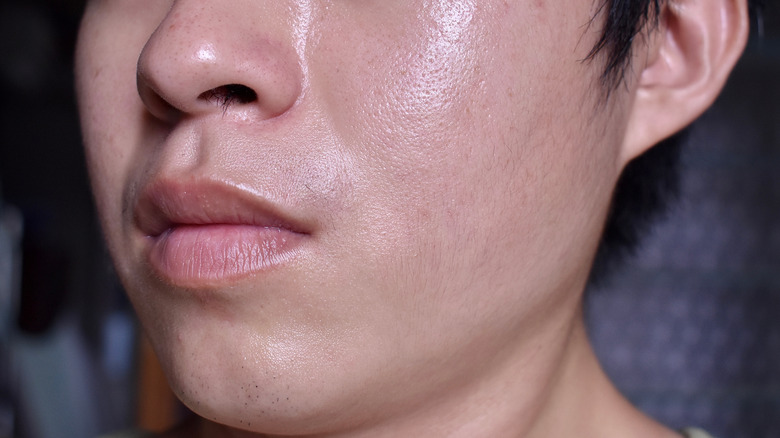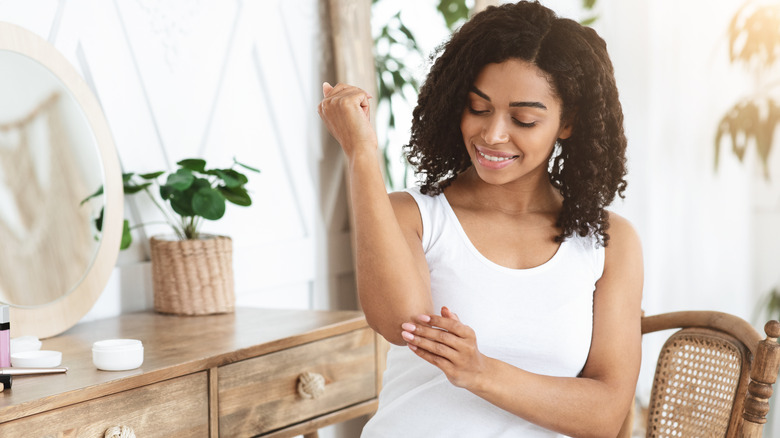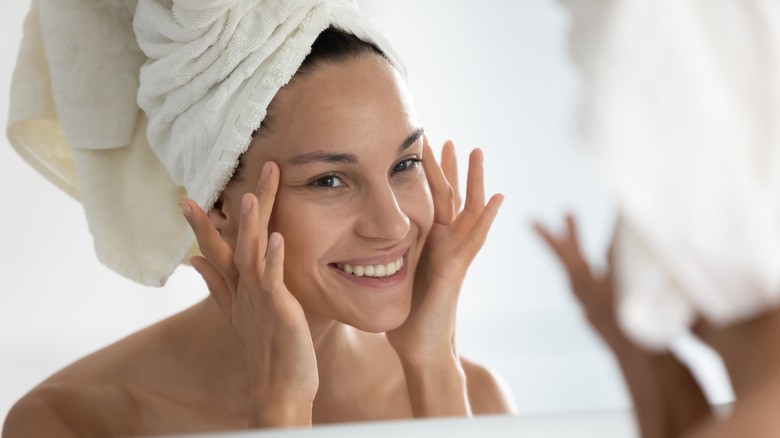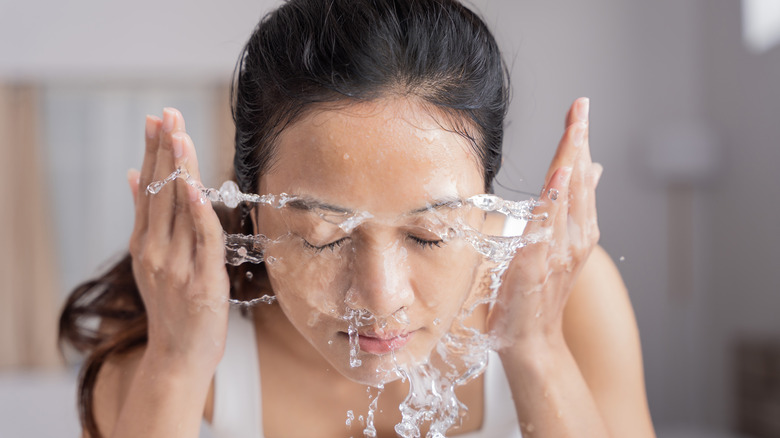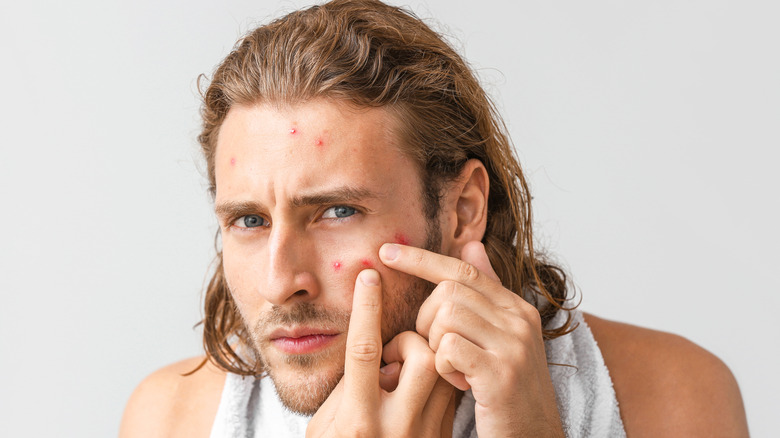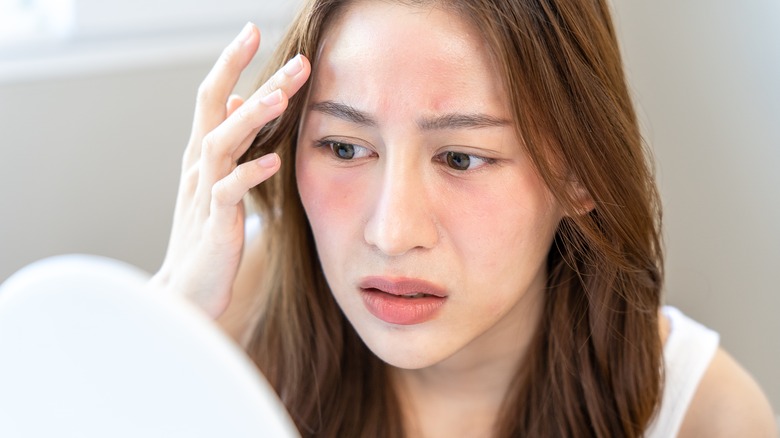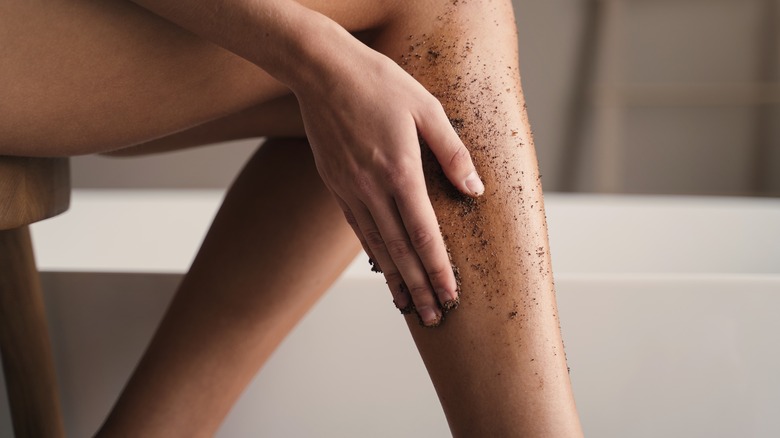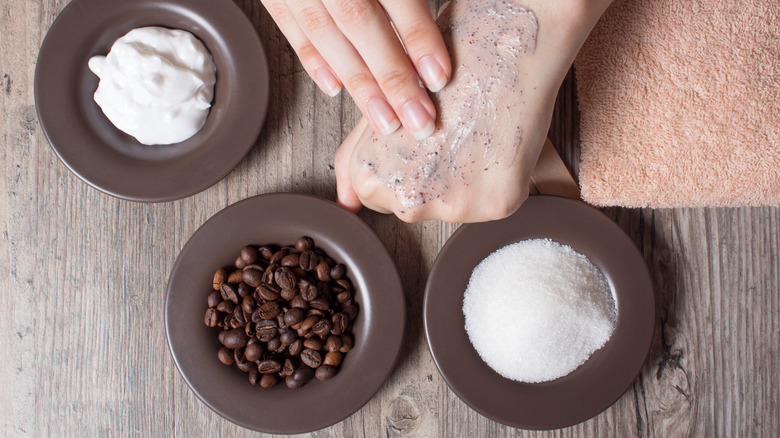How To Properly Exfoliate According To Your Skin Type
We may receive a commission on purchases made from links.
The skin of the human body is our biggest organ and the one that is the most exposed to the environment, stress, and daily bumps. Most of us are aware of the steps we should be taking to care for it: cleanse, tone, exfoliate, moisturize. Not that we're not all guilty of skipping a few steps after a particularly grueling day, but the most skipped of those is exfoliation.
Many people don't think they need to exfoliate every day, or they don't do it because they're just not exactly sure how. No worries; we got you. It might not seem like there's that much to exfoliating, but it is worth examining the ins and outs of it to make sure that you're doing it correctly according to the time, type of skin you have, and other complications that might be present in your life. Exfoliation helps to brighten your complexion and increases the penetration of your skincare products, says Dr. Avnee Shah to Women's Health.
Some of you have been put off by exfoliation because you've had real issues with it in the past. After all, red and itchy skin post-exfoliating, dryness, and peeling are all side effects of exfoliation gone wrong. Amateur beauty gurus might have even told you that those were good signs. They're certainly not! The process is not painful when done correctly, and it can even make you feel refreshed and your skin invigorated.
Types of exfoliation
There are two different types of exfoliation: mechanical or physical and chemical. All of the products in the exfoliating category will fall into one of these camps. Mechanical exfoliation consists of using scrubs, brushes, sponges, or gloves to physically remove dirt, impurities, and dead skin from your body (via Women's Health). Basically, anything that you have to work with yourself will be a mechanical form of exfoliation.
Chemical exfoliation is the process of using acids or chemical reactions to remove layers of skin and impurities. Most chemical exfoliators utilize alpha hydroxy acids (AHAs) or beta hydroxy acids (BHAs) in their formulation to slough off dead skin cells and anything else attached to them. Which one you use depends on the type of skin you have as BHAs are better for oily, acne-prone skin and AHAs are good for improving the appearance and brightness of your skin and can also help improve sun damage.
Furthermore, Dr. Avnee Shah tells Women's Health, that even retinoids can be used as a form of exfoliation. This is because retinoids work by improving cell turnover so they will exfoliate your skin to a certain degree. Whether you use extra exfoliation with your retinoid is up to the kind of skin type you have and how often you use your retinoid.
When to exfoliate
Nutritionless, a newspaper for beauty and nutrition based in Washington, D.C., helps us to answer the age-old question of when exfoliating is best done: in the morning. After a night of letting your body work and do its thing with your skin, morning is when it is prepped for exfoliation as it most likely has a layer of dead skin cells that is ready to be shed.
This doesn't mean that you shouldn't be, or can't, exfoliate in the evening or during your nighttime routine. Gentle exfoliation then can be helpful to remove any leftover residue from your makeup, and it can still be good for your skin to be exfoliated then, especially if you didn't exfoliate in the morning. For most people, exfoliating twice a week is also usually enough to keep their skin clear and clean and, coincidentally, that is also the recommended number of times for using a retinoid every week. As for the order that exfoliating should take in your cleaning routine, it should be done after both you cleanse and tone your face, per Nutritionless.
Determining your skin type
Before we talk about how to properly exfoliate your skin, let's determine what kind of skin you have. There are many camps into which your skin may fall: oily, dry, combination of normal and dry, combination of normal and oily, acne-prone, sensitive, or mature. Don't fret if it doesn't seem like your skin is not a perfect fit for any of these categories; there are 16 different types of skin. Dr. Leslie Baumann developed the Baumann Skin Type Indicator, a test that categories and identifies the type of skin that you have, in 2004, and it can categorize your skin into one of 16 slots.
According to Derm Collective, there are a few tests that you can perform on yourself at home to see how your skin reacts. The "day test" consists of simply washing your face in the morning, patting it dry, and then letting it free. Observe how your face looks at the end of the day; is it dry, maybe you have some oily patches, does it feel tight, or do you have acne? Meanwhile, the "wash test" is the same but you examine your face after about 30 minutes instead. The "blot test" has you wash your face and leave it bare for three hours and then use some blotting paper to see just how oily your face is. Lastly, the "pressure test" evaluates your skin's suppleness by having you apply pressure and observing the elasticity of your skin.
Skin type: oily
Oily skin will benefit the most from mechanical exfoliation, according to Healthline. After a day of sloughing through the environment, wearing makeup for multiple hours, and touching your skin with all kinds of objects and your hands, oily skin will also have an extra layer of grime and dirt that will need to be washed off before going to bed. Oily skin will be particularly prone to gathering extras as the oil will act as a glue to dust and particles from the air.
Oily skin will usually then need to be cleansed and toned well during your nighttime routine and even exfoliating more regularly than most other people will likely be a good thing. With oily skin, you can exfoliate up to four times per week without causes of concern unless your dermatologist tells you differently.
Of course, if you're exfoliating at night you can still exfoliate in the morning but you must be extra careful to not overdo it. Use gentle exfoliation treatments each time so your skin does not get too roughed up with multiple sessions. Those with oily skin can use manual brushes to exfoliate, sponges, or scrubs. As mentioned before, brushes and sponges should be used with gentle pressure and motions and finer scrubs should be preferred over scrubs with large particles such as coffee or salts.
Skin type: dry
Since dry skin is already prone to being flaky and itchy, you need to take great care when you exfoliate. But this doesn't mean that you don't need to exfoliate if your skin is dry; exfoliating is an important step in the skincare routine that shouldn't be ignored by anyone with skin, any type of skin. Those with dry skin will need exfoliating on a much less regular basis, though. In fact, only twice per week is recommended, per Women's Health.
As someone with dry skin, your exfoliator should help you remove dry, dead skin but also add hydration at the same time so your skin doesn't become irritated. Scrubs that include hydrating oils such as jojoba oil or almond oil can be a good choice or a scrub that has more of a lotion consistency will be good for your dry skin. Chemical exfoliators can be recommended by your dermatologist depending on your skin but usually, they're not used by those with dry skin as much.
Dry skin will likely be better exfoliated in the morning after the body has had time to work and push to the top the dead skin that it wants to get rid of. This will help you start the day off right with clean, fresh skin and also help your makeup or face products stay on your skin all day without it flaking or drying out too much.
Skin type: combination, normal to dry
Those with some kind of combination skin, whether normal and dry or normal and oily, can usually take advantage of most exfoliating products and methods (via Healthline). Physical and chemical exfoliators are all acceptable for normal to dry skin as long as you take great care around the parts of your body that are drier. To keep it safe, use scrubs with moisturizers, just as someone with dry skin would, but your skin is not as sensitive, so you shouldn't be too worried. You can even up the ante to a medium-grade scrub. These will include scrubs that use sugar, Himalayan salts, or coffee as their main ingredient for their scrubbing power.
Since you have combination normal and dry skin, you should also stick to the two-a-week recommended schedule for exfoliating. Your most effective time for exfoliating will also be in the morning to slough off any dead, dry skin cells from the night before and to start the day off with fresh skin, ready for anything the day throws at you.
Skin type: combination, normal to oily
If you have combination normal and oily skin, it means your skin is more agreeable to exfoliation than most. Both physical exfoliators and light chemical ones can be used on your skin. Since you have oily patches on your skin, you can exfoliate up to four times per week and still keep your skin healthy and fresh. You should build up to that though, making sure that your skin can take the repetition of it. If you notice that your skin is looking healthy and not becoming oily with just two exfoliating sessions a week, don't increase the number of sessions.
Physical exfoliators are still a better option for those with normal to oily skin as you can have more control over what you're doing. Light chemical exfoliators can be used as well, such as those with AHAs, as recommended by Healthline. Exfoliators with glycolic acid can also be used as it can be used to cut through the oil on your skin.
Depending on the percentage of oily to normal skin that you have, you can choose which time of day to exfoliate your skin. Exfoliating in the morning will help your skin to keep from getting oily during the day. Nighttime exfoliation can also be beneficial if you've had a particularly oily day or if you feel like your skin has become grimy during the day.
Skin type: acne-prone
Acne-prone is some of the most difficult to exfoliate because your body is already inflamed, itchy, and prone to breakouts at the drop of a hat (via Healthline). Your skin can seem particularly scary to exfoliate but it can be done and it can even be very beneficial to your skin, even potentially helping your skin to heal acne scars.
You should be avoiding physical exfoliants, whether scrubs or brushes, and focus on chemical exfoliants. Start with a low percentage AHA or BHA serum, and build from there as your skin is able to take it or as you feel necessary to cleanse your skin's pores. Both AHAs and BHAs will help to clean out your pores and fight the inflammation associated with acne-prone skin. These acids will also help to improve the texture of your skin over time, so it's a win-win!
Since your skin is more predisposed to becoming irritated and breaking out, nighttime exfoliation is ideal for you. This will keep your skin from having a potential adverse reaction at the beginning of the day and ruining your entire day. Keep your exfoliation to twice a week unless otherwise advised by your dermatologist.
Skin type: sensitive
Sensitive skin is usually brought up as a problematic area when exfoliation is discussed, and even though the American Academy of Dermatology Association recommends being extra careful with your sensitive skin, it doesn't mean that you shouldn't exfoliate as well. Physical exfoliation is definitely off the table for sensitive skin, but even chemical exfoliation should be used with caution. So, what's there to do, you ask? Stick to very light powders such as those made from rice or oatmeal. You can find an exfoliant in-store to meet your needs or, if you're particularly sensitive to an additive or other, make one yourself at home.
To exfoliate, you can mix those powders in small quantities with water or with your favorite moisturizer and apply it to the intended area. Nighttime exfoliation is recommended for sensitive skin as well so as to keep your skin from flaring up during the day. After exfoliating, moisturizer will be especially important to apply to sensitive skin.
Skin type: mature
Mature skin refers to skin that is present in those over the age of about 55, but it can also apply to those outside of that category. Mature skin is basically skin that is usually more sensitive or dry and you will usually develop it over time which means that you might start out in a different skin type category. But just because your skin has matured doesn't mean you shouldn't take care of it anymore.
Physical exfoliators with very fine particles will work well for you, according to Healthline, and chemical exfoliators will increase skin turnover rate which might help with other skin concerns as well. This can be a double-whammy of benefits for those with mature skin. Chemical exfoliators with AHAs, for example, will help to penetrate your skin deeper and improve the appearance of fine lines, keeping your skin healthy and glowing.
Mature skin should be exfoliated at night to give your skin time to regenerate during the time you're sleeping. Another thing to note with mature skin is that you might have already accumulated dark spots over your lifetime, potentially from sun damage, which needs to be carefully exfoliated, and over-exfoliation can create more of them as well.
Exfoliation your body
Usually, when we speak of exfoliating, most of us automatically think of the skin on our faces. But exfoliating the rest of your body is just as important as your face. It might not be as obvious on the rest of your body as what type of skin you have but it's usually a good bet that you can use the same types of products on your neck, arms, chest, abdomen, and legs as on your face.
There is the often-prescribed notion that the skin on the rest of your body is usually stronger and can tolerate more friction than your facial skin so you could also up the exfoliating one step from your facial process. It doesn't mean that is always the case, but you can test the idea on your own skin to see just how it works for you.
As for how to exfoliate your body, physical exfoliation is usually more likely to be used. Scrubs, sponges, and gloves are easier to use on larger surface areas and thus are more marketed toward bodily exfoliation. Chemical exfoliation can be accomplished as well and you can find them incorporated in body washes or cleansers to complete two tasks at once (via MarthaStewart.com). Bodily exfoliation can be done once or twice a week, usually in the shower, and should also be followed by moisturizing products.
Product roundup
The market is quite extensive for exfoliating options, but there are some products that are better than others. Here is a roundup of some of the best chemical and physical exfoliators that we recommend, which includes both budget-friendly buys and luxurious splurges.
Chemical exfoliators that we've found to be both budget-friendly and effective include The Ordinary Glycolic Acid 7% Toning Solution, which costs $10 at Target, and the Skin Perfecting 2% BHA Liquid Exfoliant with Salicylic Acid, which costs $13 at Nordstrom. Both of these can be good options for exfoliating mature skin, acne-prone skin, or normal to oily combination skin. You can also opt for the splurge-worthy Youth To The People Mandelic Acid + Superfood Unity Exfoliant, which is $56 on Amazon but also totally worth the investment.
Physical exfoliators we love are the Wishful Yo Glow AHA & BHA Facial Enzyme Scrub, which costs $21 at Sephora, and the EcoTools Mini Facial Cleansing Brush Infused with Citrus, which is just a mere $7 on Amazon! You can also go big and indulge in the Tatcha The Rice Polish Foaming Enzyme Powder, which is $68 at Sephora. Any of these physical exfoliators will do wonders for oily, normal to dry combination skin, and even mature skin.


